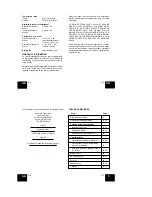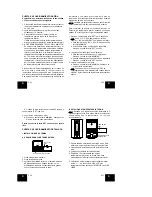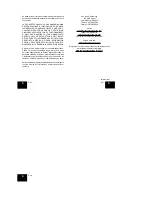
GB
P.10
GB
P.11
GB
P.12
GB
P.13
-battery installation procedures seen in section "I" of
the Detailed Set-Up Guide).
6. Install batteries into the indoor temperature station.
7. Follow the Detailed Set-Up Guide for programming and
operating instructions.
D. VIEWING AND OPERATING WITH MULTIPLE
REMOTE TEMPERATURE SENSOR UNITS
1. To view the temperature of a different remote
temperature sensor unit, press and release the "CH"
button. A shift from one "boxed" number to the next
should be observed in the OUTDOOR LCD.
2. To view the Minimum/Maximum temperature: first select
from which remote temperature sensor to read data
(indicated by the "boxed" number). Pressing and
releasing the "MIN/MAX" button will toggle through the
minimum and maximum indoor temperature, and the
minimum and maximum outdoor temperature.
3. To reset the Minimum/Maximum readings, press and
hold the "MIN/MAX" button for four seconds.
V. MOUNTING
Note
: To achieve a true temperature reading, avoid
mounting in direct sunlight. We recommend that you mount
the remote temperature sensor on an outside North-facing
wall. The sending range is 80ft; obstacles such as walls,
concrete, and large metal objects will reduce the range.
Place both units in their desired location before
permanently mounting.
A. REMOTE TEMPERATURE SENSOR
1. Remove the mounting bracket from the remote
temperature sensor
2. Mount using either screws or adhesive tape.
3. Reattach the remote temperature sensor to the
mounting bracket.
B. THE TEMPERATURE STATION
1. The indoor temperature station comes with the table
stand already mounted. If you wish to use the table-
stand, all that is required is to place the indoor
temperature station in an appropriate location.
2. To wall mount, remove the table stand. To do this, pull
down on the stand from the rear and rotate forward.
a) Fix a screw (not included) into the desired wall, and
place the indoor temperature station onto the screw
using the hanging hole on the backside. Gently pull
the indoor temperature station down to lock the screw
into place.
TROUBLESHOOTING
NOTE
: For problems not solved, please contact La Crosse
Technology via e-mail or phone, or visit our website, www.
lacrossetechnology.com
Problem: The LCD is faint
Solution: Replace batteries
Problem: No outdoor temperature is displayed.
Solution:
1) Remove all batteries, reinsert into remote temperature
sensor first, and then into the indoor temperature station.
2) Place remote temperature sensor closer to the indoor
temperature station.
3) Be sure all batteries are fresh.
4) Place remote temperature sensor and indoor
temperature station in position so the straight-line signal
is not passing through more than two or three walls.
Problem: Temperatures do not match if units are placed
next to each other.
Solution: Each temperature sensor is manufactured to
be accurate to within 1 degree plus or minus
and under normal conditions; so two
temperature sensors could be as much as 2
degrees different. However, the difference can
be exaggerated further because the
temperature sensors are designed for different
working environments. The indoor sensor is
less responsive to ambient air currents because
of the shielding effect of the display's case. In
addition, the case can act as a heat sink to
absorb and store heat from external sources (i.
e. handling of the case or radiant heat). In
addition, the much greater range of the outdoor
temperature sensor requires a different
calibration curve than the indoor range. Error
is usually greater at the extreme ends of a
range, making it harder to compare different
ranges with different curves. Under non-
laboratory conditions, it is difficult to
compensate for the above factors and obtain
an accurate comparison.
MAINTENANCE AND CARE INSTRUCTIONS
• Extreme temperatures, vibration, and shock should be
avoided to prevent damage to the units.
• Clean displays and units with a soft, damp cloth. Do
not use solvents or scouring agents; they may mark the
displays and casings.
• Do not submerge in water.
• Do not subject the units to unnecessary heat or cold by
placing them in the oven or freezer.
• Opening the casings invalidates the warranty. Do not
try to repair the unit. Contact La Crosse Technology for
repairs.
SPECIFICATIONS
Transmitting Frequency
433MHz
Measuring Temperatures
Indoor Temperature
32˚F to 156.2˚F
Station: Indoor
with 0.2˚F resolution.
(0˚C to 69.0˚C with
0.1˚C resolution)
Indoor Temperature
-21.8˚F to 156.2˚F
Station: Outdoor
with 0.2˚F resolution.
(-29.9˚C to 69.0˚C with 0.1˚C
resolution)
Transmitting range
Maximum 80 feet (25m) open
space































